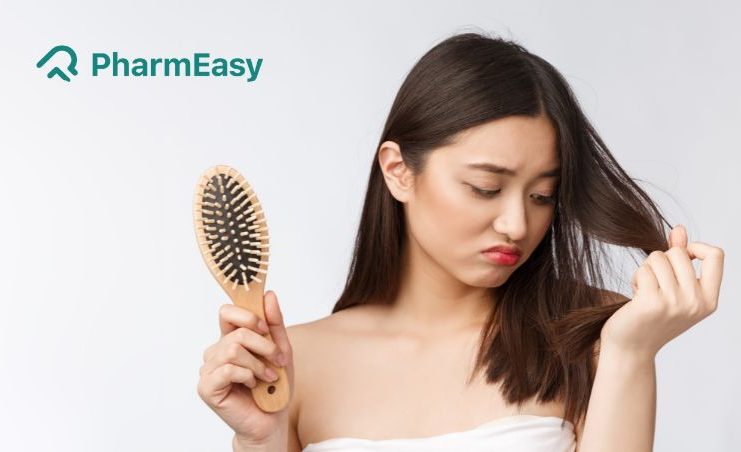What Affects Your Hair In Each Growth Phase And How To Protect Your Hair From Damage
By Saksham Bhatia +2 more

Download PharmEasy App




Register to Avail the Offer
Send OTPBy continuing, you agree with our Privacy Policy and Terms and Conditions
By Saksham Bhatia +2 more
Have you ever wondered what factors can affect your hair in each phase of the growth cycle? Understanding these influences can help you take better care of and protect your hair from damage. This article will explore how various factors can impact your hair during the anagen, catagen, telogen and exogen phases and provide practical tips to safeguard your precious locks.

Let’s dive in and discover how to keep your hair healthy throughout its growth cycle.
Table of Contents
During the anagen phase, your hair is actively growing. Several factors can influence the health and growth of your hair during this phase:
A balanced diet rich in essential nutrients, such as vitamins, minerals and proteins, is crucial for healthy hair growth. Include fruits, vegetables, whole grains, lean meats and legumes in your diet to provide the building blocks for strong and vibrant hair.
A clean and well-nourished scalp provides a healthy environment for hair growth. Regularly cleanse your scalp using a mild shampoo and conditioner to remove dirt, excess oils and product buildup. Avoid using harsh chemicals or over-washing, as it can strip away natural oils and damage your hair.
Your hair needs hydration to thrive like your body. Drink adequate water daily to keep your hair hydrated from within. Additionally, using a moisturizing conditioner can help prevent dryness and breakage.
The catagen phase is transitional when your hair follicles prepare for renewal. Although the hair is not actively growing during this phase, it is still important to protect it from damage:
Excessive use of heat-styling tools like curling irons, straighteners and blow dryers can damage the hair shaft and lead to breakage. Minimise heat exposure and when styling, use heat protectant sprays or serums to shield your hair from heat damage.
Chemical treatments, such as perming, relaxing or colouring, can weaken the hair structure if not done carefully. Always consult a professional stylist and follow their recommendations to minimise the potential damage. Additionally, give your hair enough time to recover between treatments.
Opt for protective hairstyles that minimise tension and pull on the hair. Avoid tight ponytails, braids or buns that can cause hair breakage. Instead, try loose hairstyles, braids or updos that evenly distribute the tension.
During the telogen phase, your hair rests and shedding may occur. While shedding is a natural part of the hair growth cycle, certain factors can influence the amount of hair loss:
Chronic stress can disrupt the hair growth cycle and lead to increased shedding. Practice stress management techniques like exercise, meditation, deep breathing or engaging in hobbies to reduce stress levels and promote healthy hair growth.
Hormonal imbalances, such as those occurring during pregnancy, menopause or with certain medical conditions, can impact the hair growth cycle. Consult with a healthcare professional if you suspect a hormonal imbalance and follow their recommendations for proper management.
Treat your hair with care to minimise damage during the telogen phase. Use a wide-toothed comb or a brush with soft bristles to detangle your hair gently. Avoid aggressive brushing, harsh hair accessories and tight hairstyles that can cause unnecessary hair breakage.
Also Read: What is Botox for Hair: The Guide to Transformative Hair Care
The exogen phase involves the shedding of old hair to make room for new growth. While shedding is a natural process, you can take steps to protect your hair and support healthy regrowth:
Limit excessive pulling, tugging or twisting of your hair, as it can lead to hair breakage. Be gentle when handling your hair and avoid rough towel drying or vigorous combing when wet, as wet hair is more susceptible to damage.
UV rays from the sun can damage your hair, leading to dryness and brittleness. Wear a hat or use hair products with UV protection when spending time outdoors to shield your hair from harmful rays.
Regular hair trims help to eliminate split ends and prevent further damage. Schedule regular appointments with your hairdresser to keep your hair healthy and maintain its overall appearance.
By understanding the factors that affect your hair during each growth phase and following these protective measures, you can ensure that your hair remains healthy and resilient throughout its growth cycle. Remember, healthy hair starts from within, so nourish your body, be gentle with your hair and seek professional advice when needed. Your efforts will be rewarded with luscious locks that shine with vitality and beauty.
Also Read: Flaxseed for Hair Growth: Unveiling Its Research-Based Potential Benefits
Disclaimer: The information provided here is for educational/awareness purposes only and is not intended to be a substitute for medical treatment by a healthcare professional and should not be relied upon to diagnose or treat any medical condition. The reader should consult a registered medical practitioner to determine the appropriateness of the information and before consuming any medication. PharmEasy does not provide any guarantee or warranty (express or implied) regarding the accuracy, adequacy, completeness, legality, reliability or usefulness of the information; and disclaims any liability arising thereof.
Links and product recommendations in the information provided here are advertisements of third-party products available on the website. PharmEasy does not make any representation on the accuracy or suitability of such products/services. Advertisements do not influence the editorial decisions or content. The information in this blog is subject to change without notice. The authors and administrators reserve the right to modify, add, or remove content without notification. It is your responsibility to review this disclaimer regularly for any changes.
Comments